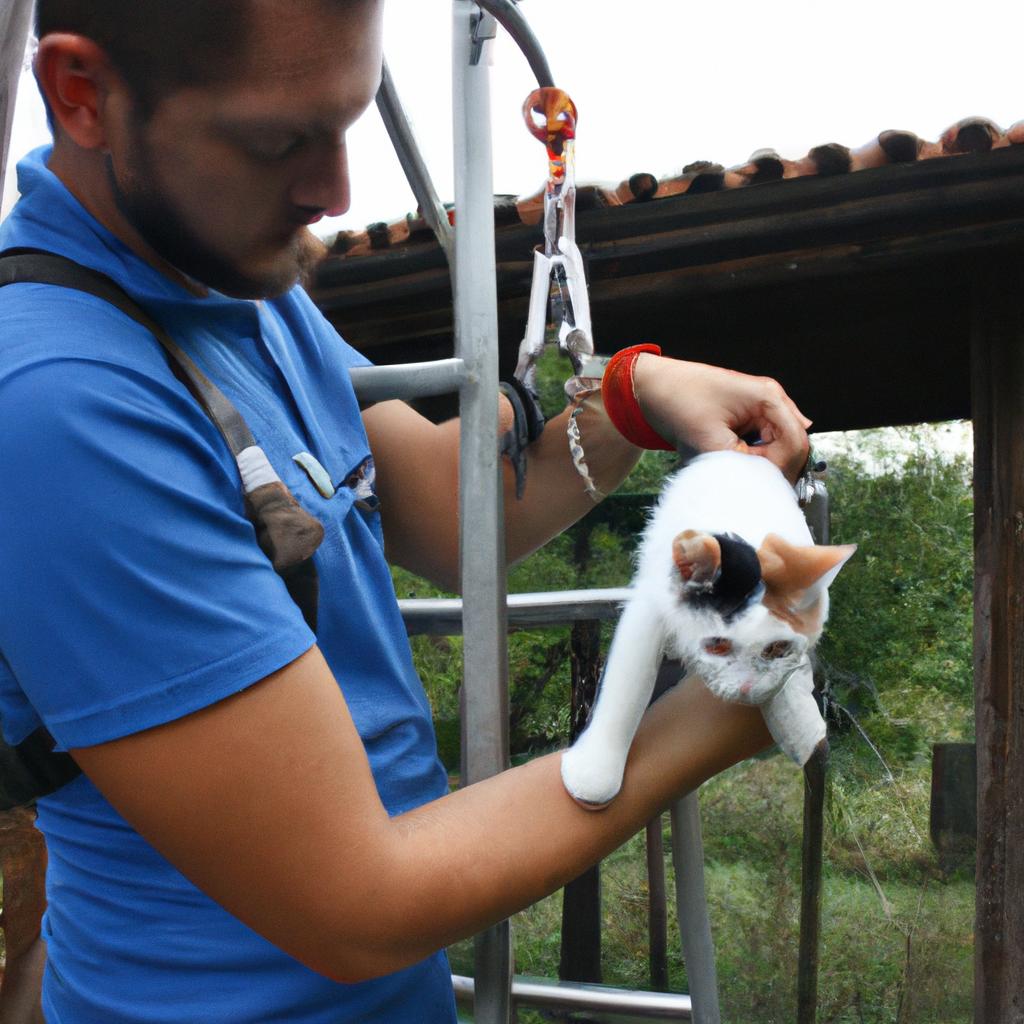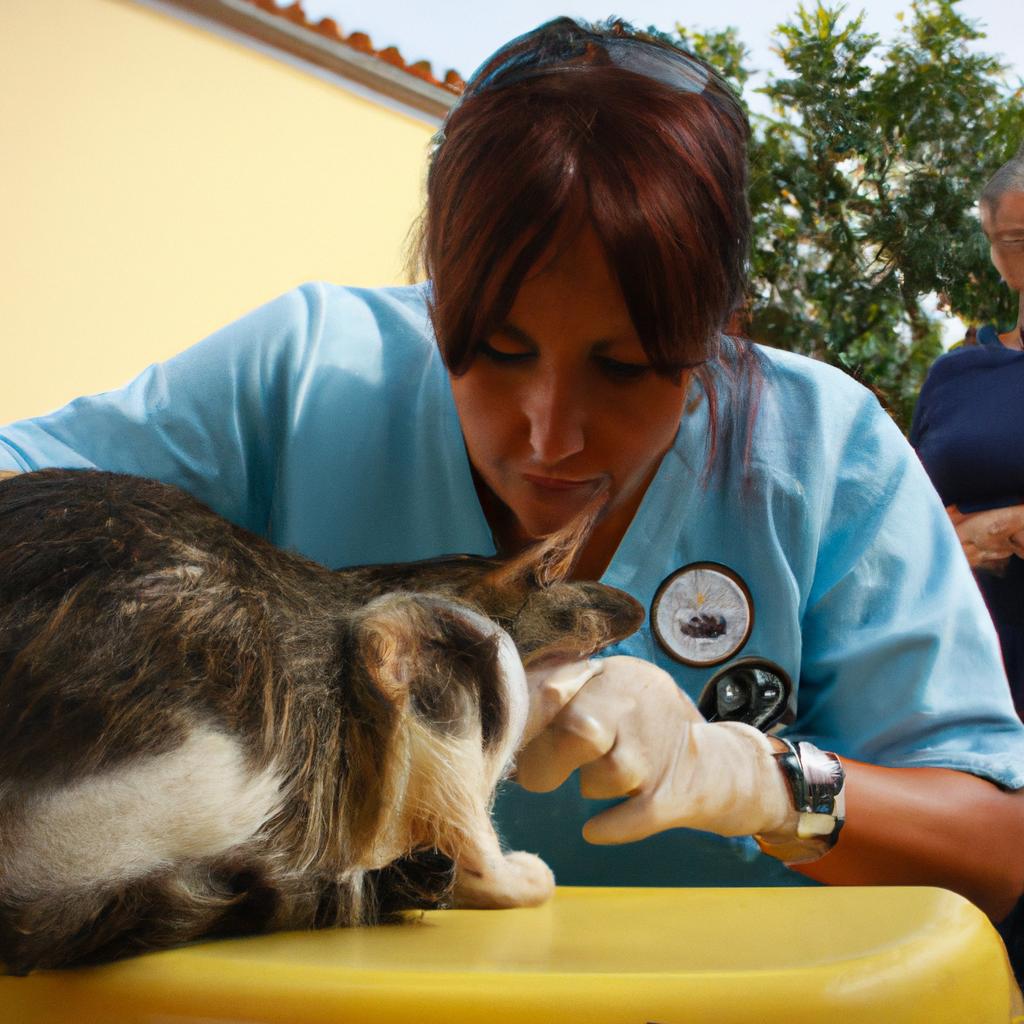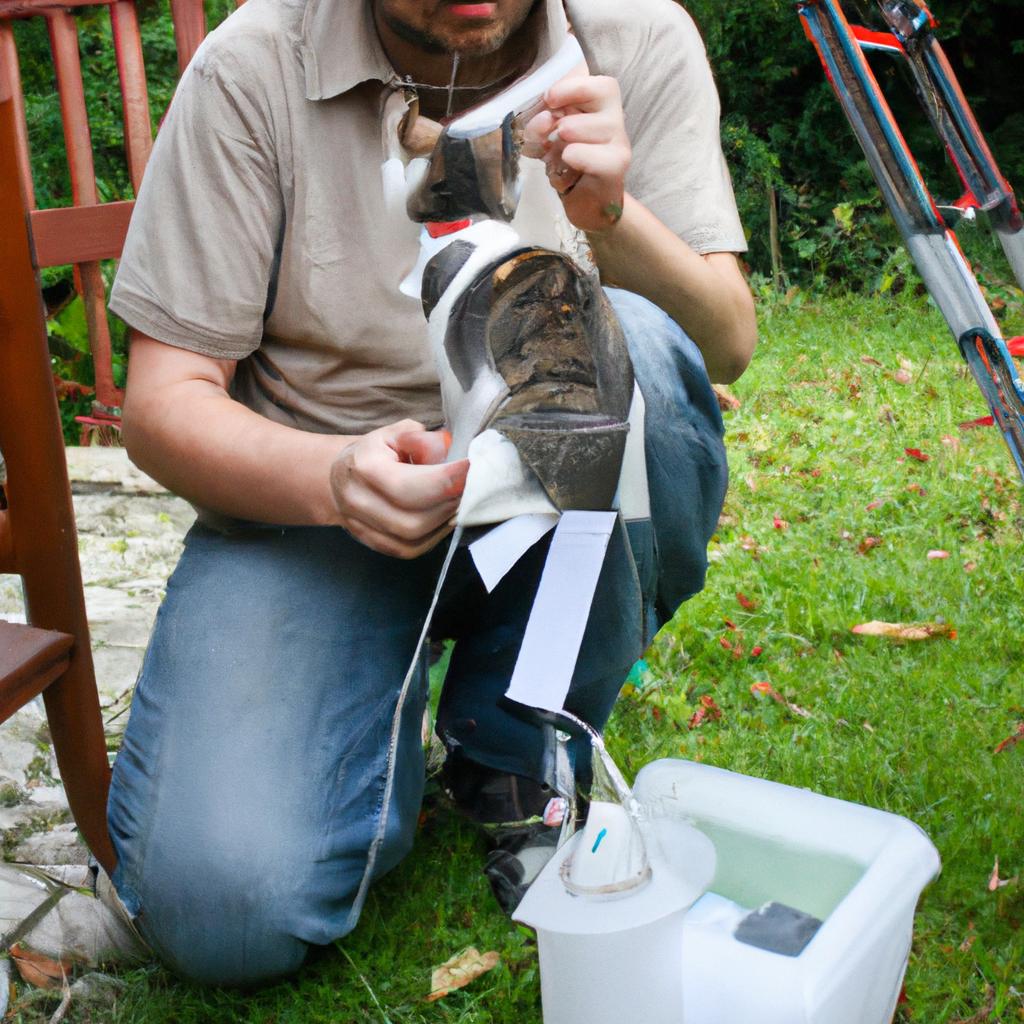Feral cat colonies are a growing concern in many urban areas, posing challenges to communities and animal welfare organizations alike. These colonies consist of cats that have either been abandoned or born into the wild, leading to overpopulation and potential health risks. In order to address this issue, various initiatives focused on cat rescue and spay/neuter efforts have emerged as effective strategies for managing feral cat populations.
For instance, consider the case study of City X, where a feral cat colony had become a significant problem within the community. This colony consisted of numerous unowned cats roaming freely, causing disturbances and raising concerns among residents. Recognizing the need for intervention, local animal welfare organizations implemented a comprehensive management plan aimed at rescuing these cats from their feral existence and reducing their numbers through spaying and neutering procedures.
In an academic approach to addressing such issues, it is crucial to examine the underlying causes and impacts of feral cat populations while exploring effective solutions for their management. By understanding the importance of proactive measures such as rescue operations and implementing widespread spay/neuter programs, communities can make significant strides towards mitigating the challenges posed by feral cat colonies. This article aims to delve further into these topics by providing insights into how cat rescue initiatives work and discussing the benefits of spay/neuter programs in managing feral cat populations.
Cat rescue initiatives play a crucial role in addressing the issue of feral cat colonies. These initiatives involve trapping feral cats and providing them with necessary veterinary care, such as vaccinations and medical treatments. Once the cats are deemed healthy, efforts are made to socialize them and prepare them for adoption into loving homes. This process not only improves the welfare of individual cats but also helps prevent further reproduction, thus reducing the overall population of feral cats over time.
Spay/neuter programs are another essential component of effective feral cat management. These programs involve surgically sterilizing cats to prevent future breeding. By spaying or neutering feral cats, their reproductive capabilities are eliminated, curbing population growth and reducing the number of new kittens being born into a life on the streets. Spay/neuter programs have been proven to be highly successful in controlling feral cat populations by preventing exponential growth and ensuring long-term population stabilization.
There are several benefits associated with implementing these initiatives. Firstly, rescuing and socializing feral cats improves their quality of life by providing them with necessary healthcare and shelter. It also gives them an opportunity to find permanent homes where they can receive love and care from responsible owners.
Secondly, spay/neuter programs have numerous advantages. They help reduce nuisance behaviors commonly associated with unaltered cats, such as yowling, fighting, spraying urine to mark territories, and roaming in search of mates. Additionally, sterilization greatly decreases the risk of certain health issues like uterine infections and testicular cancer in male cats.
Furthermore, managing feral cat populations through rescue initiatives and spay/neuter programs has positive community impacts. It reduces conflicts between residents who may be concerned about noise or damage caused by large numbers of free-roaming cats. It also minimizes public health risks associated with overpopulation, such as the spread of diseases and parasites.
In conclusion, cat rescue initiatives and spay/neuter programs are vital strategies for managing feral cat colonies. By rescuing cats from their feral existence, providing necessary care, and finding them permanent homes, we can improve their welfare while curbing population growth. Additionally, spaying/neutering feral cats helps prevent nuisance behaviors and reduces health risks. Implementing these initiatives not only benefits individual cats but also has positive effects on the community as a whole.
Understanding Feral Cat Colonies
Imagine a neighborhood where stray cats roam freely, forming a feral cat colony. One example is the case of Maple Street, where residents have reported sightings of numerous unowned cats frequently gathering in the same area. These colonies consist of cats that are typically born and raised outdoors without human interaction or care. Understanding feral cat colonies is crucial for implementing effective management strategies to address their needs.
Feral cat colonies can be found in various urban and rural settings worldwide. These communities often arise due to factors such as abandonment, lack of spaying/neutering programs, and natural reproduction. The cats within these colonies form social structures and hierarchies by establishing territories and engaging in mating behaviors. It is important to recognize that feral cats are distinct from stray cats, which are domesticated but have become lost or abandoned.
To better understand the challenges faced by feral cat colonies, consider the following bullet points:
- Limited access to food and water sources.
- Exposure to harsh weather conditions leading to health issues.
- Increased risk of disease transmission among colony members.
- Negative impact on local wildlife populations through predation.
These factors highlight the urgency for proactive measures aimed at managing feral cat colonies responsibly. Implementing Trap-Neuter-Return (TNR) initiatives has proven to be an effective approach in addressing this issue. TNR involves trapping feral cats, sterilizing them through spay/neuter surgeries, providing necessary medical care, ear-tipping for identification purposes, and then returning them back to their original habitat.
By utilizing TNR programs as part of comprehensive colony management plans, we can effectively control population growth while improving the welfare of individual cats within these communities. In the subsequent section about “The Importance of TNR Programs,” we will further explore how these initiatives contribute to reducing euthanasia rates and promoting healthier coexistence between humans and feral cat populations.
The Importance of TNR Programs
Feral cat colonies, also known as managed colonies, are groups of feral cats that live in a specific area and are cared for by individuals or organizations. These colonies often consist of cats that have been abandoned or born in the wild. To gain further insight into the dynamics of such colonies, let us consider the hypothetical case study of Colony X.
Colony X is located in an urban neighborhood where several residents noticed an increasing population of feral cats. Concerned about their wellbeing, they decided to take action and implement a cat rescue and spay/neuter initiative. By conducting regular trap-neuter-return (TNR) programs and providing ongoing care, they aimed to manage the colony’s size while improving the overall welfare of the cats.
There are several key aspects to consider when managing feral cat colonies:
-
Spaying/Neutering: The primary goal of any successful management program is spaying/neutering all cats within the colony. This process helps control population growth by preventing new litters from being born. It also reduces certain behavioral issues associated with intact cats, such as fighting and territorial marking.
-
Feeding Stations: Establishing designated feeding stations provides a stable food source for the cats within a controlled area. This practice ensures that all members of the colony have access to nutritionally balanced meals on a consistent basis.
-
Medical Care: Regular veterinary care is essential for ensuring the health and well-being of feral cats. Vaccinations can help prevent diseases such as rabies and respiratory infections from spreading among colony members.
-
Community Involvement: Engaging with local communities plays a vital role in successfully managing feral cat colonies. Educating residents about TNR initiatives fosters understanding and support, helping alleviate concerns related to noise or potential nuisances attributed to these colonies.
To illustrate how these elements work together effectively, refer to Table 1 below:
| Aspect | Purpose | Impact |
|---|---|---|
| Spaying/Neutering | Control population and reduce behavioral issues | Prevents overpopulation and curbs territorial behavior |
| Feeding Stations | Provide consistent food source | Ensures all cats have access to balanced nutrition |
| Medical Care | Maintain health of colony members | Reduces the spread of diseases among feral cats |
| Community Involvement | Promote understanding and support | Establishes a collaborative approach for managing feral cat colonies |
Implementing these strategies can significantly improve the quality of life for feral cats, as well as address concerns from communities. By managing their population size while ensuring their well-being, initiatives like those undertaken in Colony X contribute towards creating harmonious coexistence between humans and feral cat populations.
Moving forward with our discussion on implementing Trap-Neuter-Return (TNR) programs…
Implementing Trap-Neuter-Return (TNR)
Imagine a small community plagued by an ever-growing feral cat population. In this case, residents have witnessed the negative consequences firsthand – from fights and territorial marking to the spread of diseases within the colony. To address this issue effectively, implementing Trap-Neuter-Return (TNR) initiatives has proven to be instrumental in managing feral cat colonies.
To begin with, TNR programs involve trapping feral cats using humane traps and transporting them to veterinary clinics or shelters for spaying/neutering procedures. Once sterilized, these cats are then returned to their original location where they were trapped. This approach is crucial because it breaks the cycle of reproduction while allowing healthy cats to continue living in their familiar environment.
Implementing TNR initiatives requires careful planning and collaboration among various stakeholders. Here are some key steps involved:
- Community engagement and education: Raising awareness about the benefits of TNR programs fosters understanding and support within the community. By organizing workshops, distributing informational materials, or hosting public meetings, individuals can learn more about how these initiatives improve both humanely animal welfare and community well-being.
- Establishing partnerships: Collaboration between local government agencies, animal welfare organizations, veterinarians, and volunteers plays a vital role in successfully implementing TNR programs. These partnerships help mobilize resources such as funding for surgeries, trapping equipment loans or donations, volunteer recruitment efforts, and ongoing management plans.
- Organizing trap training sessions: Providing guidance on proper trapping techniques ensures that cats are captured safely without causing harm or stress to either humans or animals involved. Instructional sessions led by experienced trappers help equip volunteers with necessary skills before conducting fieldwork.
- Monitoring progress: Regular monitoring allows program organizers to assess its effectiveness over time. Data collection on sterilization rates, adoption success stories, reduction in nuisance behaviors like spraying or fighting, and overall colony stability are crucial indicators of a TNR program’s impact.
Table: Benefits of Trap-Neuter-Return (TNR) Initiatives
| Benefit | Description |
|---|---|
| Humane approach | TNR programs prioritize the well-being of feral cats by avoiding euthanasia. |
| Population control | Sterilization prevents population growth and reduces competition for resources. |
| Disease management | Spaying/neutering helps prevent the spread of diseases within colonies. |
| Community satisfaction | Residents appreciate proactive measures to address feral cat issues. |
In managing feral cat populations effectively, TNR initiatives have proven successful in reducing overpopulation while ensuring animal welfare. By implementing these strategies with community engagement, establishing partnerships, providing training, and monitoring progress, communities can take meaningful steps towards addressing this complex issue.
Transitioning into the subsequent section on “Managing Feral Cat Population Growth,” it is essential to explore additional strategies that complement TNR initiatives rather than viewing them as standalone solutions.
Managing Feral Cat Population Growth
Section: Managing Feral Cat Population Growth
To effectively manage feral cat colonies, it is crucial to address the issue of population growth. Let us consider a hypothetical scenario where a neighborhood has a growing feral cat colony that requires urgent attention. The local community, in collaboration with animal welfare organizations, decides to implement various strategies aimed at managing and reducing the population.
One key approach is through targeted trapping and sterilization programs known as Trap-Neuter-Return (TNR). By employing TNR methods, individual cats are trapped, taken to veterinary clinics for spaying or neutering, and then returned to their original location. This practice not only helps control the population but also improves the overall health and well-being of the cats involved.
The success of managing feral cat populations relies on implementing comprehensive initiatives that go beyond TNR alone. Here are some additional strategies that can be employed:
- Education campaigns: Raising awareness among community members about the importance of responsible pet ownership and encouraging them to report any stray or abandoned cats they come across.
- Community involvement: Engaging residents in volunteer activities such as feeding stations, providing shelter, and monitoring colony populations.
- Adoption programs: Facilitating adoption efforts by promoting feral kittens’ socialization and offering incentives for individuals willing to adopt rehabilitated cats from managed colonies.
- Collaboration with veterinary professionals: Partnering with local veterinarians who can provide discounted services for spay/neuter procedures or offer resources for medical care needs within these colonies.
Table: Benefits of Managing Feral Cat Populations
| Benefits | Description |
|---|---|
| Reduced nuisance | Controlling population growth helps minimize noise disturbances caused by mating behaviors. |
| Healthier cats | Sterilized cats experience improved health outcomes due to reduced risks of certain diseases. |
| Enhanced safety | Fewer conflicts between feral cats and community members, reducing the potential for injuries. |
| Environmental | Population stabilization prevents excessive predation on local wildlife, preserving ecosystems. |
Successfully managing feral cat populations requires a multifaceted approach that combines TNR programs with educational campaigns, community involvement, adoption initiatives, and collaboration with veterinary professionals. By addressing population growth in a holistic manner, communities can improve the welfare of both feral cats and their human counterparts.
Transition to the subsequent section: Building Partnerships with Community Organizations
By building partnerships with various community organizations committed to animal welfare, further progress can be made in tackling the challenges associated with feral cat colonies. Let us explore how such collaborations can contribute to long-term solutions for bettering these communities.
Building Partnerships with Community Organizations
Having discussed the effective management of feral cat population growth, it is equally important to emphasize the significance of building partnerships with community organizations. By working collaboratively, individuals and organizations can amplify their impact and address the challenges associated with feral cat colonies more effectively.
To illustrate the benefits of partnering with community organizations, let us consider a hypothetical case study. Imagine a small town grappling with an increasing number of feral cats roaming its streets. Local animal welfare group A has been conducting trap-neuter-return (TNR) initiatives but struggles to cover all areas due to limited resources. In contrast, organization B focuses on providing temporary shelters for stray cats while seeking permanent homes for them. Recognizing that they share a common goal, A and B decide to combine forces by pooling their knowledge, expertise, and resources. This partnership allows them to tackle both spay/neuter efforts and shelter provision simultaneously, resulting in greater success in managing the feral cat population in their community.
Building partnerships between community organizations offers several advantages:
- Increased reach and coverage: Collaborating with different groups expands the geographical scope of TNR programs and ensures comprehensive coverage within a region.
- Enhanced resource utilization: Sharing resources such as traps, veterinary services, volunteers, and funding enables more efficient use of available assets.
- Knowledge exchange: Partnering fosters learning opportunities among organizations involved in various aspects of cat rescue initiatives like trapping techniques or adoption processes.
- Amplified advocacy efforts: Combined voices carry more weight when advocating for policies supporting humane treatment of feral cats or increased public awareness about spaying/neutering pets.
| Advantages of Building Partnerships |
|---|
| Increased Reach and Coverage |
In summary, forging alliances between community organizations brings together diverse skills sets and perspectives towards addressing feral cat challenges more comprehensively. By sharing resources, knowledge, and amplifying their collective voices, these partnerships have the potential to create a significant positive impact on feral cat colony management.
As we transition into discussing the long-term benefits of feral cat colony management, it is important to recognize the role that community organizations play in creating sustainable solutions for this issue.
Long-Term Benefits of Feral Cat Colony Management
Building on the importance of partnerships with community organizations, an effective feral cat colony management program should also consider the long-term benefits it can bring. By implementing strategies that focus on rescue and spay/neuter initiatives, communities can make a significant impact in addressing the issue of feral cat overpopulation.
One compelling example is the case study of Greenfield City, where a collaboration between local animal shelters and volunteer groups successfully managed a feral cat population that had grown out of control. Through their joint efforts, they were able to implement a comprehensive trapping, neutering, and releasing (TNR) program. This initiative involved capturing feral cats, providing them with necessary veterinary care including spaying or neutering, vaccinations, and microchipping if possible, before returning them to their original location. The success was evident as the number of kittens born each year reduced significantly.
To further emphasize the significance of such programs, let us explore some key emotional responses associated with feral cat colony management:
- Empathy: Knowing that countless unwanted kittens are born each year only to face harsh conditions highlights the urgent need for intervention.
- Compassion: Recognizing that these animals deserve humane treatment drives individuals to advocate for proactive measures like TNR programs.
- Responsibility: Understanding our role as caretakers of these vulnerable creatures prompts action towards finding sustainable solutions.
- Hopefulness: Witnessing positive outcomes from successful management initiatives instills optimism for a future where every feline has access to proper care.
This emotional connection is reinforced when we consider the potential long-term benefits resulting from robust feral cat colony management efforts. To illustrate this point effectively, let’s examine some advantages through the following table:
| Long-Term Benefits | Description |
|---|---|
| Reduced Strain on Shelters | Lessens overcrowding by preventing unnecessary intake of stray and abandoned cats. |
| Improved Public Health | Minimizes the spread of diseases commonly associated with feral cat populations, benefiting both humans and animals. |
| Enhanced Ecosystem Balance | Controls predation on local wildlife and reduces competition for resources among native species. |
| Community Cohesion | Encourages collaboration between individuals, organizations, and government entities for a common cause. |
In conclusion, by focusing on rescue efforts and implementing spay/neuter initiatives within a feral cat colony management program, communities can address the root causes of overpopulation while enjoying long-term benefits such as reduced strain on shelters, improved public health, enhanced ecosystem balance, and increased community cohesion. Embracing empathy, compassion, responsibility, and hopefulness allows us to create a more humane world for these vulnerable creatures while fostering harmony in our shared environments.




